Successful businesses are built on effective stories. People love to see, read or hear stories because it creates a human connection based on empathy.
The best marketers in the world leverage the power of storytelling to improve branding and conversion rates. What do stories have to do with marketing? Well, people remember stories 22x more than facts and figures alone and, thus, storytelling can boost conversion rates by a significant 30%. In fact, Neil Patel has said that “62% of B2B marketers rated storytelling as an effective content marketing tactic”:
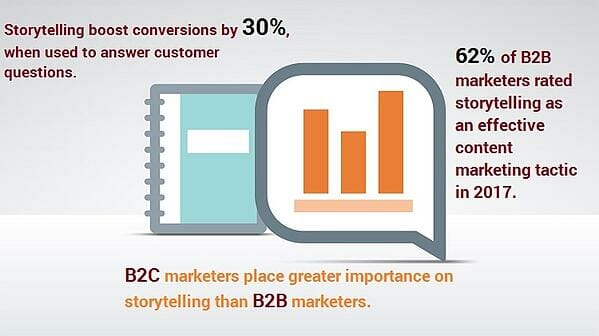
Still, many businesses lack any type of storytelling in their marketing strategy – which no doubt has a direct impact on the ROI of their marketing campaigns.
In this article, I’ll help you understand what storytelling is, why it’s important for marketing and what some of the best ways to market your business via brilliant storytelling campaigns looks like.
What Is Storytelling?
A story is an “account of imaginary or real people and events told for entertainment,” and storytelling is simply the art of sharing a message in the form of a story.
The teller conveys a message in order to connect with other people (in this case, the target audience). The message includes a protagonist plus a number of other characters, a central plot, some conflicts or obstacles, a theme (one idea that recurs throughout) and a narrative arc. If you think about classic fairy tales, they were magical tales that embodied all these points and always sought to teach the reader or listener (often children) a lesson.
So in summary, a good story should be:
- Contagious
- Easy to understand
- Emotive
- Believable (unless it’s a fairy tale or a Quentin Tarantino film)
- Useful
- Inspiring
- Inclusive
In the words of the National Storytelling Network:
“Storytelling is an ancient art form and a valuable form of human expression…. [It] is the interactive art of using words and actions to reveal the elements and images of a story while encouraging the listener’s imagination.”
Science Behind Storytelling
Stories are not just about imagination; there is real science working behind it. Storytelling is known to increase the levels of Oxytocin – a hormone that promotes the feeling of love, bonding and well-being – in your body:

Oxytocin is released by the posterior lobe of the pituitary gland, a pea-sized structure at the base of the brain and is stimulated when people hug, bond socially or fall in love. As a matter of fact, our brains are actually wired to connect with stories.
What do marketers want from their campaigns? A strong and happy bond with their customers. And storytelling is able to build that bond for them. In fact, 92% of consumers want ads that feel like stories:

Why Is Storytelling Important for Marketing?
From oral storytelling in prehistoric times to hieroglyphic storytelling in Ancient Egypt to our modern-day movies, stories have always found a special place in our lives. When there are sufficient details and authentic emotions in the tale, the listener or reader is able to connect to a story easily – and brands can use this device to make people understand how their products add value to their lives:
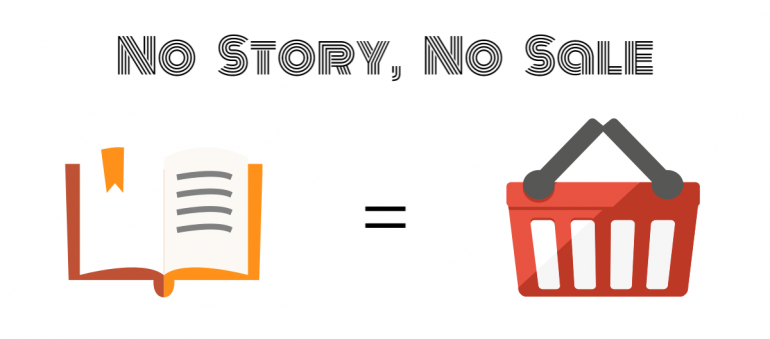
Here are some of the primary reasons why storytelling is an absolute necessity for marketing:
- It helps to build a deeper and stronger connection with the audience.
- It adds a human element to your content and, thus, brand.
- Storytelling goes beyond advertising; it makes people trust your brand much more easily.
- It lets businesses engage with customers in a fragmented media world.
- Stories helps bind your content together which otherwise might seem scattered.
- Stories help share your brand vision in the most pleasant manner.
- A business with a great story is able to defeat its competitors easily.
- Stories are the most successful weapon to create brand loyalty, which means that people are much more willing to promote your product or brand by word-of-mouth marketing, which is the best way to popularize a business.
Dive Deeper:
5 Principles of Storytelling
If you want to transform your ordinary product into something extraordinary, you need to market your services with impressive storytelling. And in order to implement storytelling in your marketing strategy, you need to understand the principles of storytelling.
Here are the 5 basic principles of storytelling that every business should follow:
1) Choose a Relatable Main Character
A story is incomplete without a main character. The protagonist, or hero, adds a face to the story to which people can relate.
You need to choose a character that makes it easy for audiences to understand your story and you need to make him or her attractive (not as in “good looking”; as in “appealing”). This character should be interesting and well-defined enough to leave an impression in the minds of the people:
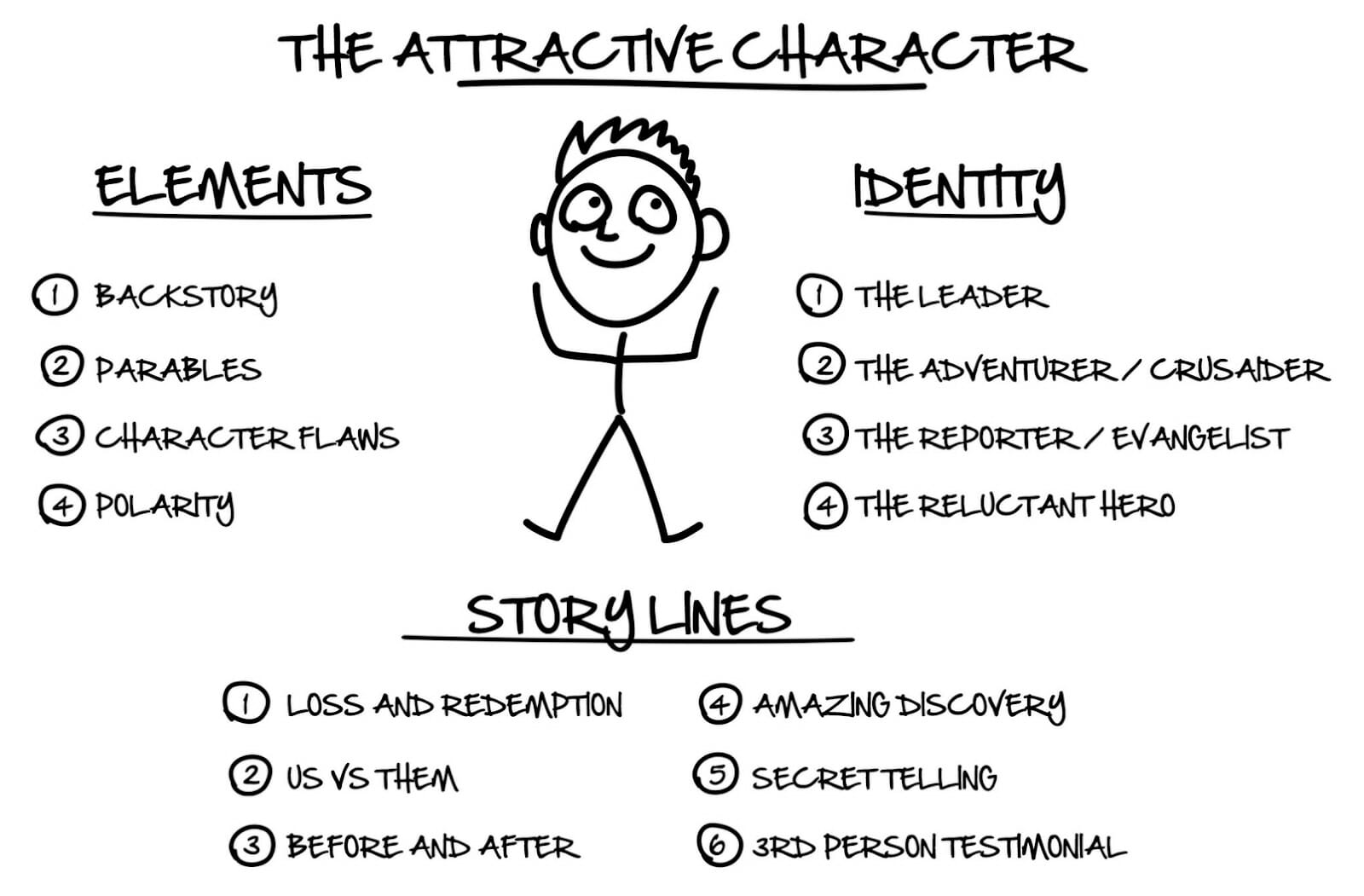
Your entire story must revolve around this person. People remember unique characters and therefore your protagonist must be able to give your story that extra edge in order to remain at the forefront (examples of this below).
2) Put the Best Elements in the Beginning of Your Story
Just as with an article with a great hook, you should put the best elements of your story at the beginning rather than saving “the best” for the end. You want to immediately lure the reader or watcher into your story and compel them to share your blog or video with others.
The title of your story and a short, snappy description (think movie loglines – Raiders of the Lost Ark: An archeologist is hired by the U.S. government to find the Ark of the Covenant before the Nazis do) plays a great role in making your story attractive.
For example, instead of using a title like How I Became An Entrepreneur that doesn’t connect with the audience, use a title like How I Started Earning $100,000 Per Year. The second title is much better because here you have put the best element of your story – the juicy detail: money – at the beginning.
This is what Melyssa Griffin did in her blog post and guess what? The post received more than 125 comments and counting:

Related Content: How to Write Hero Headlines to Skyrocket Click-Through Rates
3) Create “Conflict”
It might sound strange but, yes, conflict in your story helps keep your audience engaged. Now, how do you create conflict in your brand’s story without getting your CFO arrested for bank robbery?
Author Cathy Yardley uses a simple formula for this called GMCD:
- Goal – What does your point-of-view character in the scene want to achieve or attain? In other words, what is the scene’s object of desire?
- Motivation – Why does your character want to achieve that goal and why is it important?
- Conflict – What is standing in the way of your character’s achieving their goal?
- Disaster – What is the result of the scene’s conflict? Yardley outlines three possible options:
- The character doesn’t get what they want.
- The character doesn’t get what they want and something worse happens.
- The character does get what they want, but something else goes awry as a result.
So, you need to make your customers or niche influencers the hero of your story and when we first see them, they have an issue or a problem that they want to solve, or a desire or action they want to achieve.
At the beginning, they must fail (or already have failed) with whatever they are trying to achieve. If they immediately get what they want, yay for them, but there is no story.
Then, add differing opinions and obstacles to create conflict that gets in the way of the hero achieving their goal.
Finally, when the protagonist finds your product or service, the obstacles are overcome and they achieve their desire and/or fix their problem. Things should fall into place only at the end.
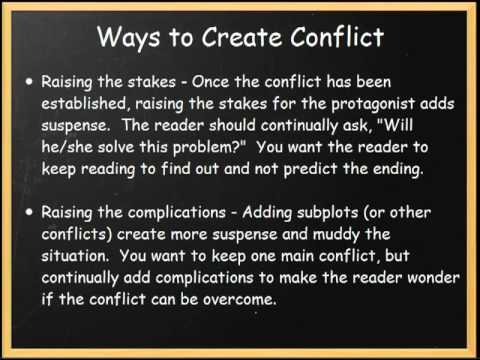
Watch the full 5-minute video on creating conflict in a story:
4) Understand the Relationship Between Listening and Telling
There is a reciprocal relationship between listening to and telling stories. Just imagine that you are telling a story to a group of people, but they aren’t interested in listening to you. Will you be able to tell your story? Nope.
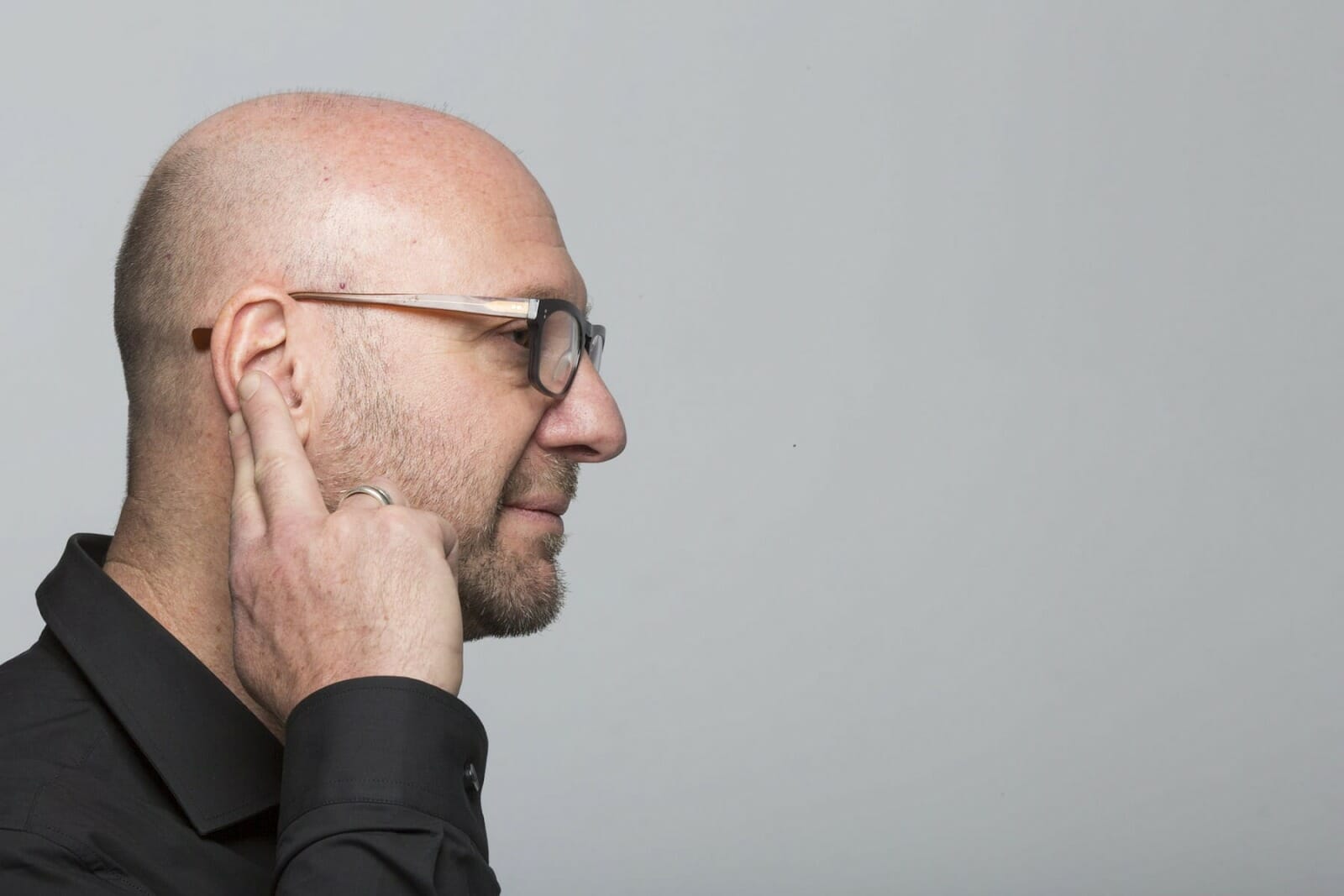
Identify the obstacles to getting your audience to listen to you, such as:
- External obstacles
- Physical obstacles
- Internal obstacles
- Psychological obstacles
- Relational obstacles
Once you’ve eliminated as many of the obstacles that you can, make sure that you are implementing #1, #2 and #3 above. This will give you the best chance of really being heard.
In the case of marketing, getting your audience to listen to your story means understanding their mental state, their likes and dislikes, their attention span, their behavior, etc. Otherwise, all your efforts are wasted.
Dive Deeper: The Ultimate Guide to Developing Buyer Personas (with Templates!)
5) Keep Your Story Authentic
People love authenticity, which is the fastest way to connect with another human being. It is up to you to produce a story that is genuine and unique. Do not steal other people’s ideas or try to come across as someone you are not just to impress them (that’s like your parents acting like teenagers to impress your friends).
As long as you stay true to your brand, it will be easy for people to react (and connect) to your story. In other words, your brand personality should be reflected in your story, so if you are a rule-bending startup, create a funny or irreverent narrative. If you are a traditional law firm, create a reassuring and professional narrative.
Either way, your story should be simple and focus on a single problem fo which a solution to the problem is clearly offered at the end. Remember, this story is not a sales ad. You want your story to connect with customers so that product buying happens naturally.
Have a look at the below example from Patagonia, the outdoor clothing brand. Patagonia shares authentic stories from real customers called “The Stories We Wear” on their website:
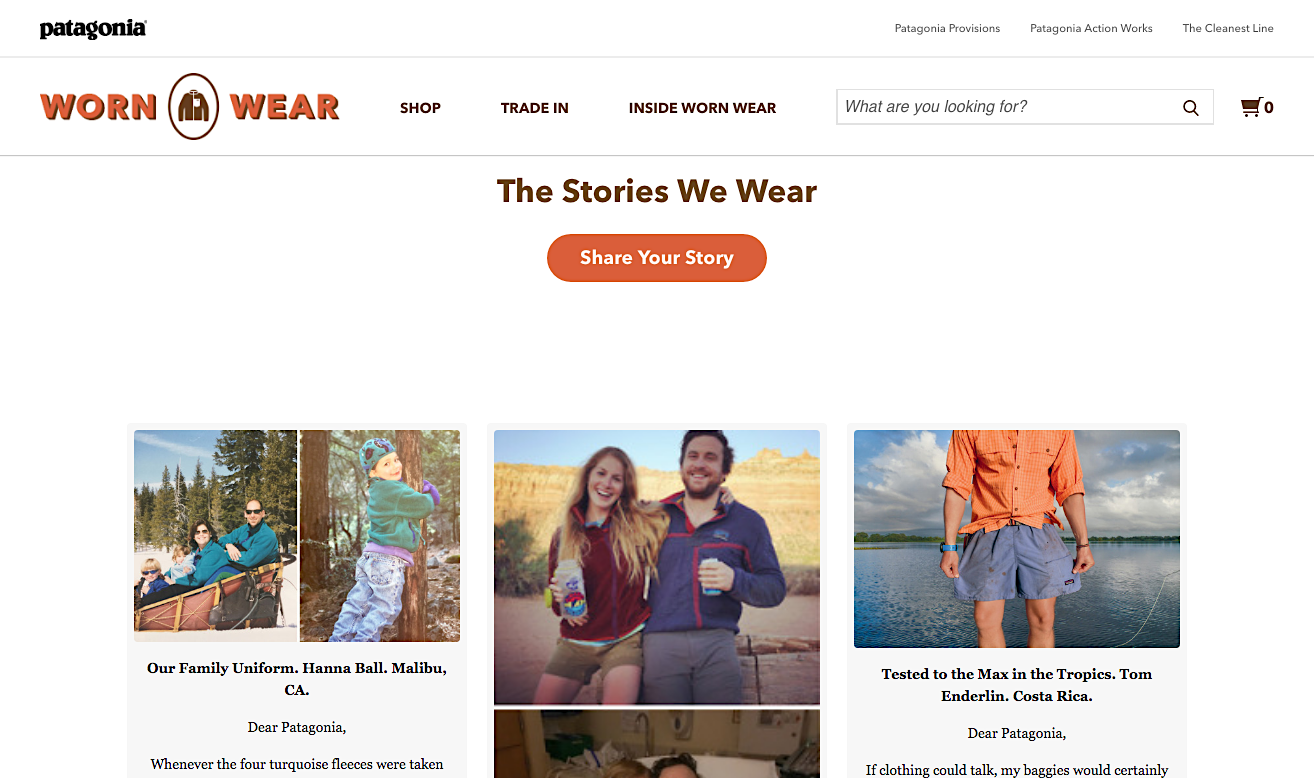
People buy products after reading the stories associated with those products, so what is more authentic than this?
Related Content: 7 Creative Ways to Make Your Blog Posts Stand Out
7 Brilliant Examples of How Brands Use Storytelling
Storytelling is the best way to persuade your audience to buy your products or services without engaging in direct selling. Here are 7 brilliant examples of brand storytelling in action that can inspire you to tell your own story:
1) Dannijo – Connect with Your Audience with Inspirational Videos
Dannijo is a jewelry brand founded by sisters Danielle Snyder and Jodie Snyder-Morel.
The brand has grown in tremendous popularity because of the storytelling strategy they’ve used. The sisters say that authentic storytelling is key to creating a successful lifestyle brand.
On their Instagram account, they share pictures of their own lives along with photos of celebrities wearing their jewelry. They also post inspirational videos by interviewing other influencers in their niche:
They even started a popular podcast named No Filter with Danielle Snyder where they interview the world’s most influential individuals to get their story.
All these efforts of user-generated content storytelling helped Dannijo acquire new customers and generate referrals from their existing customers.
Key Takeaway: Remain authentic and share something inspirational with your audience. Invest time in interviewing others or being interviewed by others. Stories based on real life are some of the best in the world.
Related Content: 12 Engaging Types of Video Content that Viewers Love to Watch
2) IKEA – Use Humor to Promote Your Products and Services
IKEA Singapore uses humor and hilarious puns in their storytelling videos to illustrate practical storage and furniture solutions.
This video is entitled Improve Your Private Life and is narrated by Fille Güte, a “Shelf-Help Guru”. It features a typical husband and wife arguing about the lack of space in their bedroom — and then the Shelf-Help Guru comes in with a solution: IKEA’s Pax wardrobe, Malm drawers, Komplement interior fittings, etc.:
The video uses humor:
- Wife: I just wish you knew what to do with your junk.
- Husband looks mortified. Camera pans down to his hips, then refocuses on the pile of junk on the floor of their small bedroom.
- Cut to Shelf-Help Guru suggesting IKEA furniture to solve the problem of space in their bedroom and, at the same time, saving their marriage.
The ad ends by saying “Begin your journey of shelf discovery”. This story is something that every couple faces at some point in their relationship, and IKEA hits all the right points. It’s a common story with a unique touch! You can even see in the video comments below how much people love IKEA’s humorous ads.
Key Takeaway: Don’t be afraid to get personal with your customers. Be funny but stick to your brand values at the same time. Use an influencer to convey your message and offer a solution to the problem.
3) BACARDÍ – Celebrate Your Culture Through Music
BACARDÍ is the largest spirits company in the world. In the video BACARDÍ presents the Sound of Rum: Dancehall Kings & Queens, they share the story of the vibrant dance culture in Jamaica and how it has progressed. The video features Jamaican music industry legends and today’s innovators to see how the music has been adopted across Europe.
Key Takeaway: Create a niche video featuring the culture of your target audience. People are always interested in learning something new about their own culture or a culture about which they don’t know. Be creative and don’t forget to feature influencers.
4) Warby Parker – Show Your Customers What’s Behind the Scenes of Your Brand
Warby Parker is an American eyewear brand. In their storytelling video, they don’t focus on showing just their products; instead, they feature their culture, people and values.
In the video How Warby Parker Glasses Are Made, they explain the step-by-step process of creating a glass right from the cutting of the lenses. People are able to understand the exact process and hard work that goes into preparing a glass and why their product is the best. Not only that, but we get to learn their story, such as the fact that for every pair of glasses sold, they donate a pair to someone in need.
Key Takeaway: Show your brand culture and people with “behind the scenes” videos. Feature the founder of the company and let your audience know why your product is so unique. People should “see” instead of “being told”. This is the essence of showing brand culture and product manufacturing to your customers.
Dive Deeper:
5) Dove – Share Stories About Real People to Stir Up Emotions
Dove is one of the first brands that popularized the idea of featuring their customers in their videos. Mostly they’ve featured women, but recently the company made a shift and featured men (dads) in their videos. The concept was amazing.
In their video Dove® Men+Care® Mission: Care, they show a man named John reuniting with his family on Father’s Day outside his U.S. military base after talking about how hard it is to be away from his kids for months at a time.
This video is a true story created with the Operation Homefront to let military personnel reunite with their families on special occasions – and I dare you to watch it without tearing up!
Key Takeaway: Focus on real people and use authentic emotions in your story. Your brand motto must match the story moral presented in the video. In the case of Dove, it was “we care for you”.
Related Content: 5 Ways SMB Business Owners Can Revamp Their Digital Marketing Strategy
6) Huggies – Use Data to Create a Touching Story
Global diaper brand Huggies leveraged the power of hugs to win moms emotionally.
At one time, Pampers had 100% of Canadian hospital contracts for supplying diapers. Huggies had to increase their market share, so in order to defeat Pampers, they created and promoted a campaign named “No Baby Unhugged”.
Their campaign was based on research that proved that hugs help stabilize babies’ vital signs, ward off illness and promote brain development. Their video features a mom and her newborn baby in the hospital. Mom is seen to hug her baby and the caption “Hugs strengthen your baby’s immune system, they promote weight gain and improve brain development” was displayed.
It promoted the use of Huggies diapers in hospitals and pressed on the message that Huggies is the best gift a mother can give her baby.
The result of the campaign was amazing with sales of Huggies Newborn Diapers increasing by 30%.
Key Takeaway: Educate people about your product and create a story that features your product’s USP (Unique Selling Point). Use data and research to back up your suggestions and leverage the power of story and emotions to persuade people that your product is best.
7) Nike – Reach Out to Your Audience with a Web Series
Nike has gone a step ahead in storytelling by launching an 8-episode mini web series on YouTube.
The series was named Margot vs Lily in which Lily challenges Margot to make a fitness web show that gets 1,000 followers and Margot challenges Lily to find at least three real friends. Here is a preview of the first episode entitled Resolutions:
Check out the full episode here.
Nike decided to invest in creating actual content (as opposed to ads) as a new way for them to inspire fans and persuade them to exercise and live a healthy life. As a side note, the characters in the series are seen wearing Nike products, but it is not a sales pitch. The series focuses on the emotions that are part of the personal fitness journey (frustration, dejection, lack of motivation). The result was amazing and people liked the show very much. It had a rating of 7.4 on IMDb!
Key Takeaway: Think of your target audience when you are storytelling and identify the channels where they spend most of their time. Think ahead to the future: Nike created a web series back in 2016 when the trend of watching web series was slowly catching up among Millennials. It smartly capitalized on the channel by investing in master storytelling that resulted in tremendous brand success.
Dive Deeper: How to Build a Strong Personal Brand Using Webinars
Storytelling Formats for Advertisers
You must always identify the right format for your story because not all stories are created equally.
For example, you need to use video to show something and not tell. Similarly, images should be used to make a statement. Below are the different types of storytelling formats for advertisers:
1) Mini Ads
This is a form of storytelling where advertisers create mini video ads to connect with audiences and deliver their message. The videos are about 6-10 seconds long and have the power to drive customer engagement without content overload.
Facebook has already launched 6-second ads to deliver faster messages and drive instant action from audiences. Similarly, YouTube now offers Bumper Ads which are 6-second video ads for driving brand reach and conversions:
Check out this compilation of 6-second bumper ads:
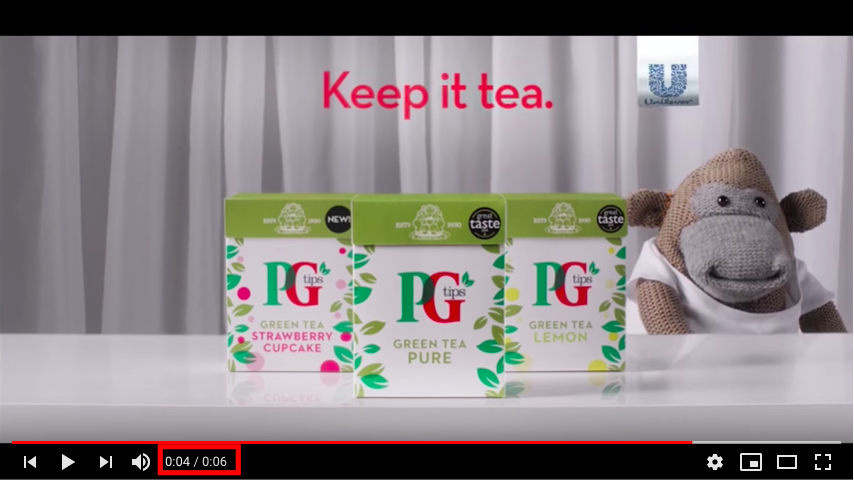
“What can you say in six seconds? Most likely, more than you think. Many large brands are using bumper ads to drive upper-funnel goals like ad recall and awareness. Bumper ads are a cost-effective way to reach your target audience, ensure your message is seen and heard (with nearly all YouTube ads viewable and audible), and keep you top of mind.”
Get Inspired:
2) Data-Based Storytelling
You can always expand the capabilities of storytelling if you power it up with data. Any story that makes use of data to convey the message is known as data-based storytelling.
Often, the story is automatically created just by compiling some data and presenting to users in a presentable format.
Here is an example of data-based storytelling where Google shares the year’s biggest moments and the questions they inspired (you can explore many examples of data-based storytelling under Google Trends):
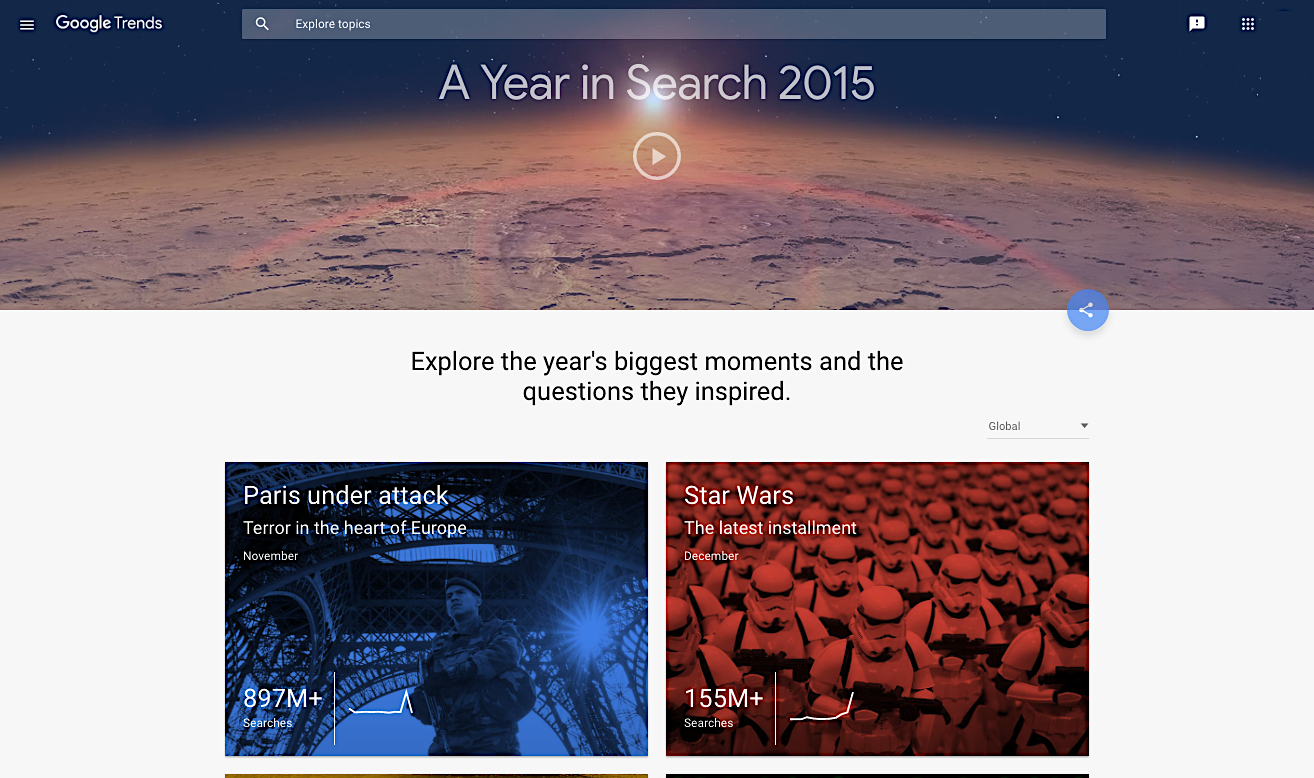
Dive Deeper: How To Write Data-Driven Posts
3) Long-Form Storytelling
Storytelling isn’t just video. You can create long-form stories in a presentable manner using text and images.
Long-form stories are different than shorter video content: If you are using text and images to tell your story, then you must opt for long-form stories. For video stories, short and crisp is preferred.
Research by Orbit Media revealed that bloggers who create stories of more than 2,000 words reported stronger results when compared to the ones who created stories fewer than 500 words:
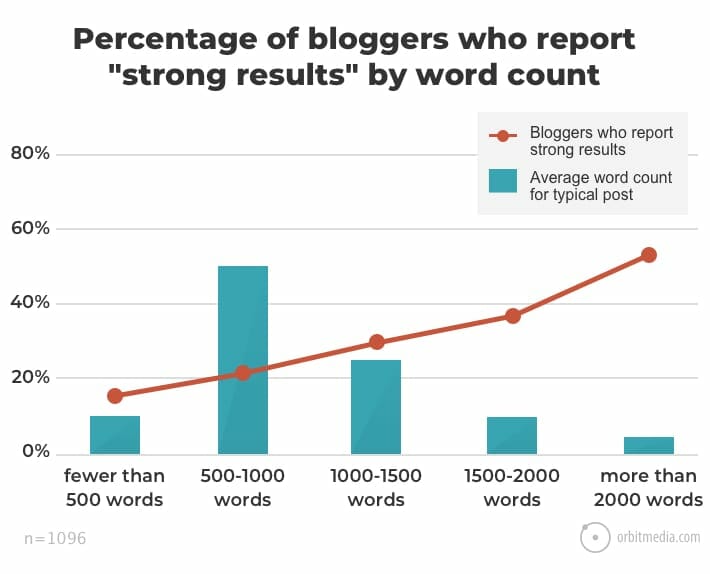
Here is an example of long-form storytelling on the topic Modern Women in the Land of Genghis Khan created by BBC. It uses parallax scrolling to provide a 3D effect to the story and makes reading it fun:
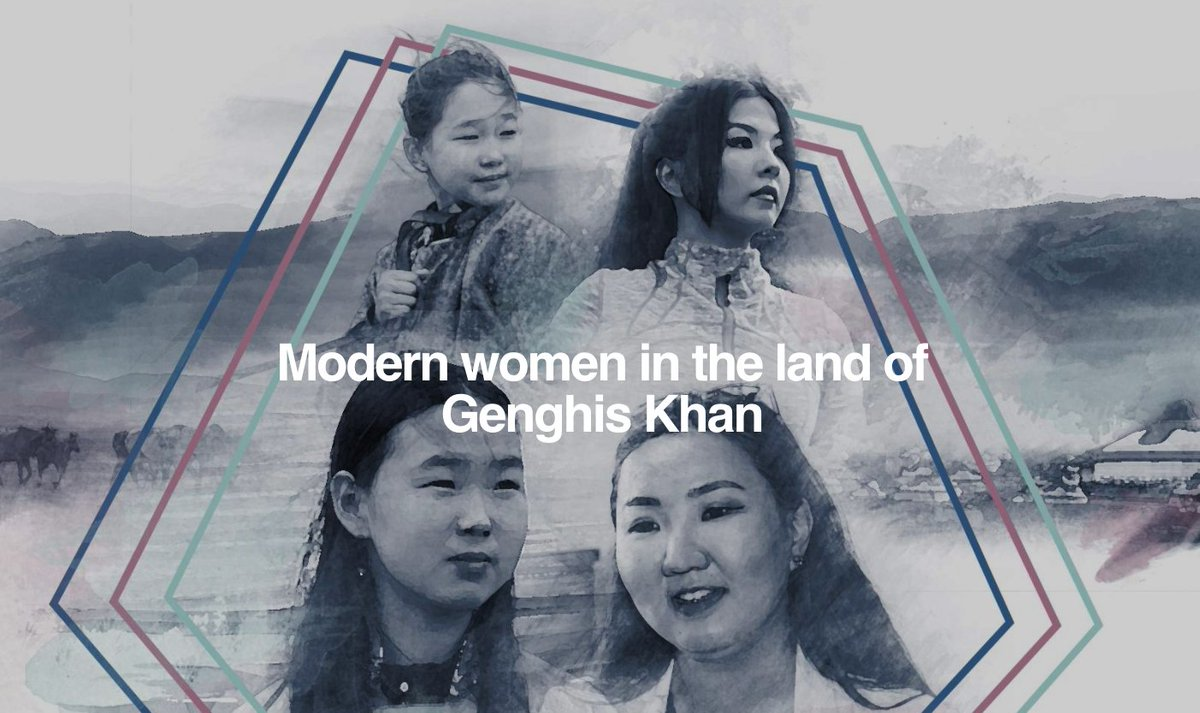
Dive Deeper: 22 Digital Marketing Trends You Can No Longer Ignore in 2019 & Beyond
4) Personalized Storytelling
People love to read stories that they find meaningful. This is what makes personalized storytelling so powerful.
With this form of storytelling, you allow the reader to choose the story that matches his/her interest. It’s more of a personal choice than what you as a brand would offer.
Have a look at this story of Policing the Schools created by NBC:

The reader chooses the school district where they live and the content automatically adapts itself based on that choice:
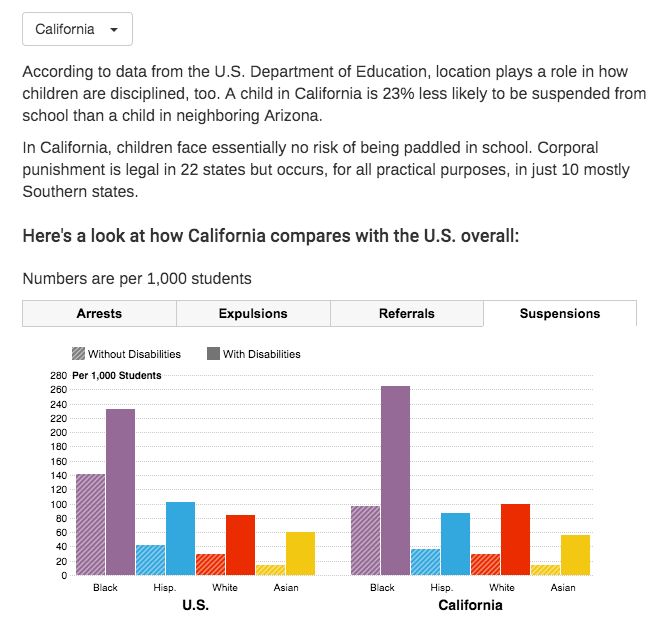
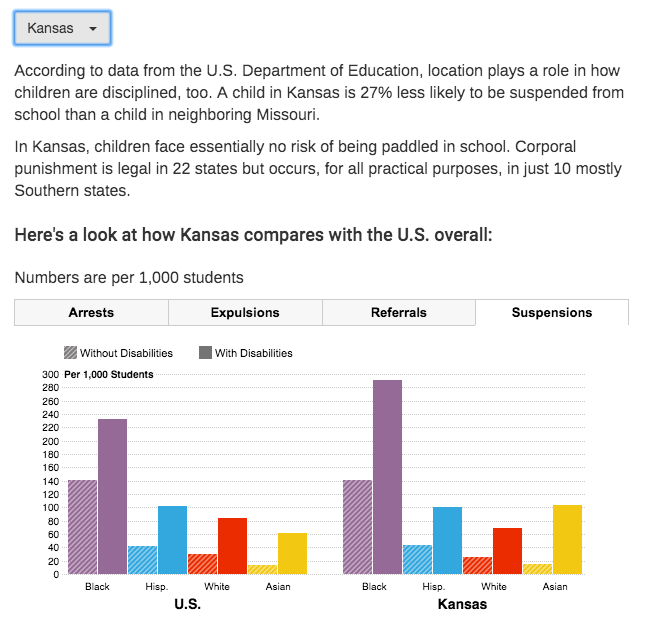
Dive Deeper:
5) Audio Storytelling
Stories can also be told through recorded conversations. You can create podcasts and allow your audience to listen to it.
A great example of this form of storytelling is StoryCorps, an oral history project that started in 2003. With just one story booth, they recorded interviews and preserved the recordings to be heard at a later date:

StoryCorps is a master of sharing stories related to humanity. Here is the complete collection of their stories that you can listen to get inspired and improve your own branding efforts:
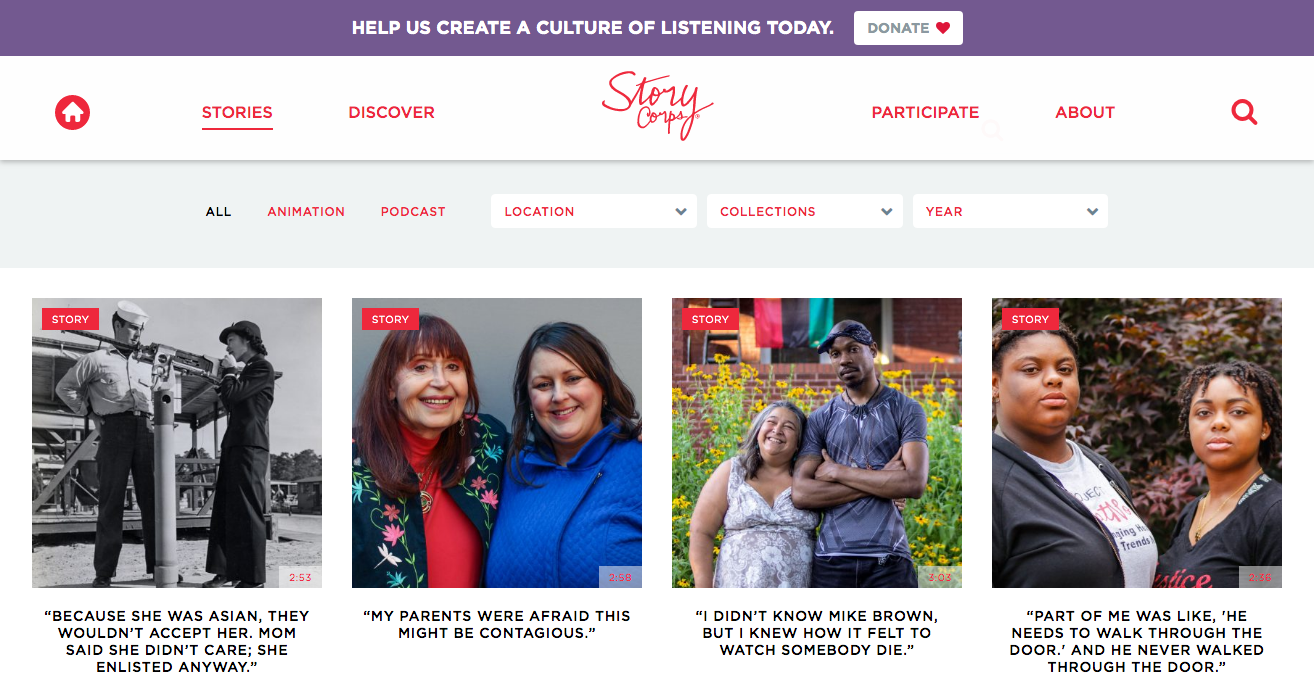
Dive Deeper:
Final Thoughts
Brand storytelling is the future of marketing. When data and stories are used together, they are able to move your audience both intellectually and emotionally. Story is one of the most powerful mediums to convey your message because it is remembered much longer than facts and figures, and people are more likely to be persuaded.
The best stories in the world are not necessarily your own. User-generated stories are often able to inspire people much more than brand stories. Follow the examples shared in this article and power up your marketing campaigns with effective storytelling!
